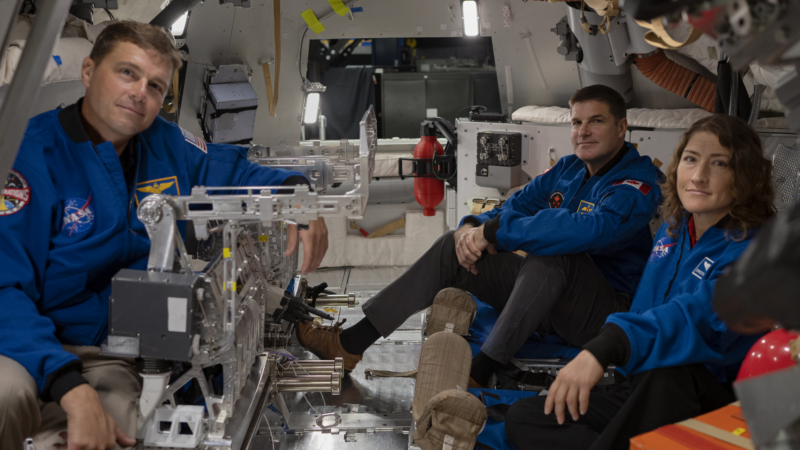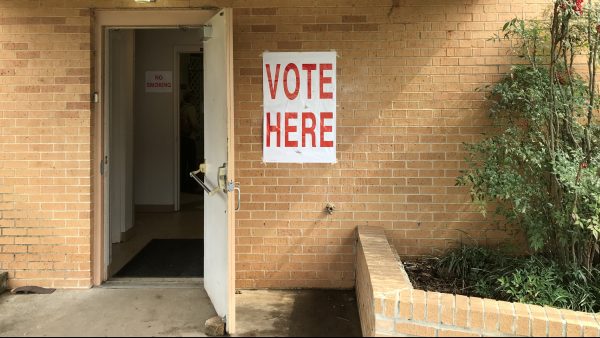Meet the astronauts preparing to travel farther from Earth than any human before
NASA’s Orion space capsule is not a place you would describe as “roomy.”
The not-quite-cone-shaped spacecraft is about 12 feet across on the inside, and, aside from the center that slants up toward a hatch door, it’s mostly less than five feet tall. Moving around it — in gravity at least — is an awkward process of crouching and ducking.
““It’s a lot bigger in 3D, when you can float around,” mission specialist Christina Koch says. “That’s what I’m telling myself.”
As soon as a year from now, Koch will be in that chrome-colored capsule, flying toward the moon at thousands of feet per second. She and two of the four total Artemis II crew members were available on a recent late-August day to show NPR how they’re preparing for their mission around the moon and back, which will be the first human flight to Earth’s satellite in more than half a century.
The capsule Koch and other NASA employees showed NPR isn’t the real thing, though. It’s a full-scale training mockup at the Johnson Space Center in Houston, where the crew has been spending hours at a time familiarizing themselves with the layout and running through the paces of their upcoming mission.
Mission commander Reid Wiseman explains a dizzying panel of screens, knobs and switches. He points to the velocity monitor.

“When we leave planet Earth we’re zero miles an hour and when we hit low-Earth orbit we’re doing 17,000 miles an hour. And then when we come back into the atmosphere we’re doing 39 times the speed of sound, 25,000 miles per hour.” Wiseman says. “Crazy numbers.”
This time next year, if all goes according to plan, Wiseman will command a key moment in NASA’s Artemis program. Over the course of 10 days, the crew will travel to the moon, swing around its orbit, and slingshot back to Earth.
A history-making mission, for multiple reasons
Along with Koch and Wiseman, mission specialist Jeremy Hansen and pilot Victor Glover round out the crew. Koch, Hansen and Glover will be the first woman, Canadian and Black astronauts, respectively, to head to the moon.
The mission’s high ambitions also come with equally high stakes, as the spacecraft is designed to travel more than 250,000 miles, taking them farther away from Earth than any human before, all while moving at incredible speeds.
This mission is the second phase of NASA’s broader Artemis program: the first sent the Orion space capsule along this path uncrewed in 2022. The goal of Artemis II will be to test out the Orion capsule and all the other equipment, so that by 2026, Artemis III can put astronauts back on the moon.
The program’s overall ambitions go far beyond replicating NASA’s Apollo glory days.
“The goal is not just to go back to the moon,” NASA Administrator Bill Nelson told NPR in May. “The goal is to go to the moon to learn so we can go farther to Mars and beyond. Now it so happens that we’re going to go to a different part of the moon. We’ll go into the South Pole, and that is attractive because we know there’s ice there in the crevices of the rocks in the constant shadow or darkness. And if in fact there is water, then we [can create hydrogen] rocket fuel.”


The further the plans stretch out, the more they may seem like science fiction. A key eventual component of Artemis will be a moon-orbiting space station.
But first, NASA needs to make sure it can get a human crew to the moon and back. That’s where the four Artemis II astronauts come in.
They’ve been training since April 2023, spending hours inside the mockup capsule, practicing the various physical tasks they’ll need to carry out on the mission. That means hours of looking around its small interior, thinking about what it will be like to share the space with three other people.
The astronauts laugh knowingly when asked about this, because for all the high-level science they’re cramming on, they’re intently focused on this human chemistry, too.
“We just have to trust each other,” Wiseman says.
The crew has spent a lot of time talking intentionally about how to give each other the personal space they’ll need during the high-stress mission.
“If I can’t physically go to a different space, because we’re all in the same ‘Hershey kiss’ together, then I can put on my headphones and that’s my way to signal [to the rest of the crew] that I’m in my cabin right now,” says Koch, giving one example.
A peek into the high-stakes training
Training has taken the astronauts to the Pacific Ocean, where they’ve practiced how they’ll get out of the capsule and into helicopters after their mission ends in a splash down. They’ve hiked in Iceland, to learn more about the volcanic geology they’ll be observing on the lunar surface.
The most critical training, though, happens in the high-tech simulator on the Johnson Space Center campus — the same building that has housed simulators going back to NASA’s Gemini program.

“The goal in this building is to serve the needs of the flight control team, to train them so that if they have a bad day in the real mission, it’s like automatic to them,” says Grace Lauderdale, the simulator manager for the Orion, where she heads a team of NASA engineers, physicists and computer scientists. Lauderdale and her team come up with different scenarios that have one unexpected problem or another flare up at different points, so that if and when something does go wrong in space, it isn’t unexpected.
The windows of the simulator are fitted with monitors that display a digital rendering of Earth, the moon and stars. The astronauts can then use the controls to operate simulated thrusters and virtually fly through space, practicing the rocket burns and docking maneuvers they’ll eventually carry out while orbiting Earth.
“The purpose is to train the crew in all of the devices that they have to interact with during a mission,” Lauderdale explains. “The training team takes that simulation and creates all of the training scenarios in order to train the crew, train the flight controllers, to work as a team to understand what they need to do in case something goes wrong.”
And things can and do go wrong in space exploration. The world got a vivid reminder of that reality this summer: Two NASA astronauts, Butch Wilmore and Suni Williams, will end up spending eight months on the International Space Station — instead of their initially planned eight days — because of problems with the Boeing Starliner capsule they were testing.
Artemis II is a much more complicated endeavor than Starliner, so if anything goes wrong for the Artemis II crew between Earth and the moon, the contingency plans are much more limited.

“There isn’t this kind of backup system because they’re going to be very far away,” says Moribah Jah, a professor of aerospace engineering and engineering mechanics at UT Austin.
“We don’t have more of these Orions just sitting on shelves to go launch and rendezvous with them and all this other stuff. They’re going to have to figure it out or not.”
And the high stakes and limited room for error is exactly why preparation on the ground is so essential.
“Part of the preparation of going to do something like this is understanding that there’s a … very real chance you don’t come back,” says mission specialist Jeremy Hansen. “We’re trying to understand the risks that we’re taking and make an intentional decision to accept that risk or not accept that risk. And I feel really good about this program and the leadership and their courage to make hard decisions.”
How the crew feels about ‘a supreme responsibility’
Assuming everything goes according to plan, though, the crew has quite the to-do list — and quite the view.
“Our primary task is observing, observing the moon,” said Koch. “Our job is to tell the scientists back home the things that lunar probes can’t see or tell. And that is, what colors do human eyes see? What observations, large scale, do we see? And we’re being trained to do just that, to describe and observe.”
“It’s a supreme responsibility to have eyes on the far side of the moon,” she adds.
Which leads to a key question: how often is the Artemis II crew overwhelmed by the magnitude of their upcoming task?
“I like to allow space for that every once in a while,” says Koch. ” And for me, allowing about two seconds every couple of months is enough. The enormity when it hits me is there and it’s important, but for the most part, I’m focusing on the mission and my role in it, just like any other mission.”
Wiseman admits that he sometimes dwells on it for a little more than two seconds at a time, including a recent night where he couldn’t easily get to sleep, “thinking about riding this gigantic rocket, going all the way out to the moon with Christina, Victor, Jeremy, and I had to get up and go for a walk around my living room for a second because I just couldn’t get myself back into the mode of going to sleep. And I knew I needed to rest. But sometimes it does. Sometimes it hits you.”

Besides the enormity of the mission, after more than half a century some Artemis II crew members also say going back to the moon feels long overdue.
“For me, when I look at humanity and the call to explore that humans have put out there, we were always going to go back to the moon and go back to stay,” says Koch. “There was never a time in our history as a species when that wasn’t going to happen, when we weren’t going to push further. And so our role is just really answering that call.”
Transcript:
SCOTT DETROW, HOST:
I recently found myself awkwardly crouched down, trying not to bang my head and trying to figure out how to wedge myself into a tight, low space.
REID WISEMAN: Actually kneel down…
DETROW: OK.
WISEMAN: …Kind of facing the ground.
DETROW: All right.
WISEMAN: We got to teach you how to do this like an astronaut. OK. And now you just kind of start rolling your way. Don’t scratch your watch. Yep. And now your feet come up and over. Yes. Perfect.
DETROW: That is astronaut Reid Wiseman. And it should be said, he was much more smooth about making his way into the same small nook at the front of the training mockup of an Orion space capsule at the Johnson Space Center in Houston. We were now both on our backs, laying on blue seats that, when we craned our necks up, allowed us to look out four port windows, and when we look straight forward, put us flush against a complicated panel of screens, knobs and switches, some of which they hope they never need to touch.
WISEMAN: In general, the switches are not intended to be used if everything is going well.
DETROW: OK.
WISEMAN: These switches are last-ditch efforts. Like, for here, this is main parachute deploy. So if we are in a really bad day and our main parachute does not deploy, moving this switch will send an electrical signal from the battery directly to the employment motor…
DETROW: This time next year, if everything stays on schedule, which, with an effort like this is a really big if, Wiseman plans to be in this seat commanding Artemis II, the first flight around the moon in more than 50 years. The screens display dense lines of flight data. To me, they’re all random numbers. To Wiseman, they’re telling a high-stakes story.
WISEMAN: This doesn’t look like much, but this will be the acceleration time profile for going into space. The things that we really look at are VI in the upper left. That’s our velocity. When we leave planet Earth, we’re zero miles an hour. And when we hit low Earth orbit, we’re doing 17,000 miles an hour. And then when we come back in the atmosphere, we’re doing 39 times speed of sound, 25,000 miles an hour. It’s crazy numbers.
DETROW: Wiseman and three other astronauts will spend 10 days flying to the moon and back. They’ll lift off as soon as a year from now, though the launch date hasn’t been set yet. Artemis II will be the first crewed mission to the moon since the end of the Apollo program. Its goal will be to test out the Orion capsule and all the other equipment so that by 2026, Artemis III can put astronauts back on the moon.
The Artemis program is aimed to kick start a new, more enduring era of space travel that leads to Mars. It’s also intentionally more representative than Apollo was. The Artemis program will eventually put the first woman on the moon, as well as the first person of color. It’s all as historic and high stakes as it gets and also pretty daunting.
There’s that whole 25,000-mile-an-hour reentry to think about, and also the fact the crew will have to spend 10 whole days in this small capsule, about 12 feet wide inside, but in many places, just 5 feet or so tall. The capsule is chrome silver on the outside. Inside, it’s mostly white with orange plastic pipes and beige fabric straps running along its walls. Here and there, metal boxes are bolted to the sides. And again, it all feels pretty cramped.
CHRISTINA KOCH: It’s a lot bigger in 3D when you can float around. That’s what I’m telling myself.
DETROW: Yeah.
(LAUGHTER)
DETROW: Mission specialist Christina Koch, like Wiseman, has been to space before. She spent nearly a year on the International Space Station.
KOCH: The other day, we figured out where we might all hang our sleeping bags. One person will be bat like and hang in kind of from – to describe it, in the top part of what you can imagine the capsule shape is, there’s a little bit of a little pop up, a tunnel. And so that will be where they hang either feet up or head up. And then the other folks are – kind of be more like what you might consider horizontal with what is the bigger base of the capsule or the floor, kind of.
DETROW: That seems like the cozy spot.
DETROW: That’s what I’m saying.
WISEMAN: I like how Christina didn’t identify that she has already declared that spot hers, but we know that is her spot. She can give it up if she wants, but that is her spot.
DETROW: Along with Koch and Wiseman, mission specialist Jeremy Hansen and pilot Victor Glover round out the crew. Koch, Hansen and Glover will be the first woman, Canadian and Black astronauts, respectively, to head to the moon. And they’ve now been preparing since April 2023, spending time in this mock-up capsule, familiarizing themselves with the layout. They train in different places all over the world too. The most critical sessions, though, also happen in Houston, in the simulator. Wiseman says they practice what to do when things go according to plan and when things do not go according to plan.
WISEMAN: We like to challenge our brains and see how we can work through a system. Every time you push a button, you take that split second before you push that button to think, what is this button about to do to this vehicle? And where am I going to be after I push that button? And that is a huge challenge to think through all of that.
DETROW: All the reps are useful for the astronauts, but also for the people who will be working in Mission Control.
WISEMAN: Every time we do one of these simulations, we are tied together. And it’s, how are they solving problems, and how are we solving problems? How are we talking together? They have a lot more insight into the vehicle than we do. They have other things that they can do. They have different ways of troubleshooting.
DETROW: Working together to solve problems, testing different scenarios out in the simulator.
(SOUNDBITE OF FILM, “APOLLO 13”)
ED HARRIS: (As Gene Kranz) Tell me this isn’t a government operation.
DETROW: It’s a dynamic the rest of us know from high drama space movies like “Apollo 13.”
(SOUNDBITE OF FILM, “APOLLO 13”)
CHRISTIAN CLEMENSON: (As Dr. Chuck) Those CO2 levels are going to be getting toxic.
HARRIS: (As Gene Kranz) Well, I suggest you gentlemen invent a way to put a square peg in a round hole – rapidly.
DETROW: In real life, the troubleshooting is critical, if a little less dramatic, because things can and do go wrong in space exploration. Artemis II is effectively a test flight. And while NASA has had a string of high-profile successes lately, there’s also been a vivid example in the news this summer of a test flight that has not gone according to plan.
Two NASA astronauts, Butch Wilmore and Suni Williams, will end up spending eight months on the International Space Station instead of their initially planned eight days because of problems with the Boeing Starliner capsule they were testing. They’re now scheduled to return in February on a different spacecraft. If anything goes wrong for the Artemis crew between the Earth and the moon, resources, the forces of gravity and just their sheer distance from everybody else makes the contingency plan very different.
MORIBA JAH: There isn’t this kind of backup system because they’re going to be very far away.
DETROW: That’s Moriba Jah, a professor of aerospace engineering and engineering mechanics at UT Austin.
JAH: You know, we don’t have more of these Orions just sitting on shelves to go launch, you know, the backup and rendezvous with them and all this other stuff. Like, they’re going to have to figure it out or not.
DETROW: Which is why all the training and preparation on the ground is so essential.
JEREMY HANSEN: We have super-smart people who try to dream up all the things that could go wrong, and then we try to have a backup plan or a redundant system. But at the end of the day, we also know there are the unknown unknowns, and there’s risk involved.
DETROW: The Artemis flight will be Jeremy Hansen’s first trip to space.
HANSEN: And part of the preparation of going to do something like this is understanding that there’s a, you know, very real chance you don’t come back. We’re trying to understand the risks that we’re taking and make an intentional decision to accept that risk or not accept that risk. And I feel really good about this program and the leadership and their courage to make hard decisions.
DETROW: Assuming everything goes according to plan, though, the crew has quite the to-do list and quite the view. Here’s Koch.
KOCH: Our primary task is observing – observing the moon in the short period of time that we have our flyby. We’re expecting maybe 45 minutes where we can really observe the moon. And our job is to tell the scientists back home the things that lunar probes can’t see or tell. And that is, what colors do human eyes see? What observations, large scale, do we see? And it’s a supreme responsibility to have eyes on the far side of the moon. We hope that we’ll be able to see it depending on its face.
DETROW: I do wonder, like, when you think about your mindset, when you think about what you have to do, how much just the enormity of going to the moon – I know two of you have been on the space station before. How different is it? Or do you just put that inside and say, this is a mission, I’m training for it, and that’s what I need to do? Like, do you let the Neil Armstrong of it all kind of get into your head day-to-day?
KOCH: I like to allow space for that every once in a while. And, for me, allowing about two seconds every couple months is enough. The enormity when it hits me is there, and it’s important. But for the most part, I’m focusing on the mission.
WISEMAN: Scott, as you were asking that question, that’s very similar, but I have to expand two seconds because last night, I was in bed getting ready to go to sleep. And it’s – that started, like, thinking about riding this gigantic rocket, going all the way out to the moon with Christina, Victor, Jeremy. And I had to get up and go for a walk around my living room for a second because I just couldn’t get myself back into the mode of going to sleep. And I knew I needed to rest. But sometimes it does – sometimes it hits you. And then most of the time, it’s just a – kind of in the background.
DETROW: Still, even with all of that, astronaut life does have its slow moments.
WISEMAN: There’s that great social media thing – what my parents think I do, what my friends think I do, what I actually do. And a lot of our time is spent in meetings, talking to people, thinking through the ways to tackle challenges. And I think that gets lost on folks.
DETROW: The world has changed a lot since astronauts last flew to the moon 52 years ago. The sum total of the computing technology that powered the Apollo missions is inside most people’s pockets, is on their wrists. NASA is peering into faraway black holes with high-powered telescopes. It’s crashing probes into meteors. Private spaceflight is a more commonplace reality. Just this week, for the first time, a private mission conducted a spacewalk. So after more than a half a century, going back to the moon feels long overdue.
KOCH: When I look at humanity and the call to explore that humans have put out there, we were always going to go back to the moon and go back to stay. There was never a time in our history as a species when that wasn’t going to happen, where we weren’t going to push further. And so our role is just really answering that call.
‘SNL’ has always taken on politics. Here’s what works – and why
As a historic election looms, Saturday Night Live faces an ongoing challenge to make America laugh – and process an increasingly strange political world. Jean Smart hosts the show’s 50th season premiere on Saturday.
Opinion: Remembering the marvel, Maggie Smith
Jean Brodie, Minerva McGonagall, Violet Crawley: Maggie Smith embodied these memorable roles on stage and screen. NPR's Scott Simon has a remembrance of the actor, who died yesterday at the age of 89.
Why the price of eggs is on the rise again
The price of eggs has risen by about 28% in the past year, largely due to outbreaks of avian flu. Those prices could continue to climb during the holidays, as demand for baked goods increases.
5 things to know from this week’s big report on cannabis
More Americans now use pot on a daily basis than alcohol. A sweeping new report says the federal government needs to better understand the risks to the public and get involved.
VP debates may alter a close race’s dynamic even when they don’t predict the winner
Vice presidential debates have produced many memorable moments, but it’s hard to say any has made a decisive difference in the election outcome. It’s worth recalling how much media heat and drama they have generated.
Justice Department sues Alabama saying state is purging voter rolls too close to election
Federal officials said the purge violates the “quiet period provision” of the National Voter Registration Act that prohibits the systemic removal of names from voter rolls 90 days before a federal election.






